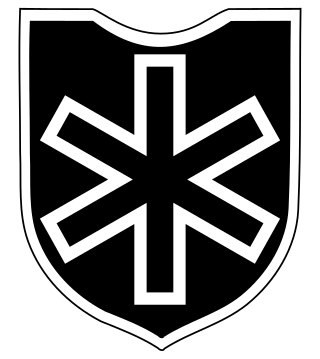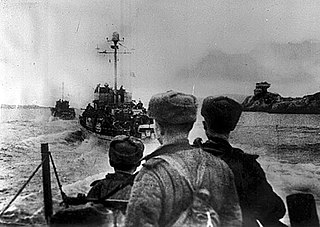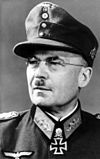
The 6th SS Mountain Division Nord was a World War II mountain infantry division of the Waffen-SS, the military wing of the German Nazi Party, primarily consisting of ethnic Germans along with some Norwegian and Swiss volunteers. It was the only Waffen-SS division to operate in the Arctic Circle.

The 169th Infantry Division was a German military unit during World War II.

Lothar Rendulic was an Austrian army group commander in the Wehrmacht during World War II. Rendulic was one of three Austrians who rose to the rank of Generaloberst in the German armed forces. The other two were Romanian-born Alexander Löhr and Erhard Raus from Moravia.

The 2nd Panzer Division was an armoured division in the German Army, the Heer, during World War II.

The 210th Coastal Defence Division was created from a Division zbV staff in July 1942, and shipped north to defend the port Petsamo in Arctic Finland. In late 1944 it moved westward to take up the defense of Vardø in the Norwegian Finnmark.

The 2nd Mountain Division was a Gebirgsjäger division of the German Army which served in World War II, mainly in the northernmost sector of the Eastern Front, near the Arctic. Formed in 1938, the division was disbanded at the end of the war in 1945.

The 3rd Mountain Division was a formation of the German Wehrmacht during World War II. It was created from the Austrian Army's 5th and 7th Divisions following the Anschluss in 1938.

The 163rd Infantry Division was a German Army infantry division in World War II. Formed in November 1939, it was engaged in the invasion of Norway the following year. It fought alongside the Finnish Army during Operation Barbarossa against the Soviet Union. During this time, the division's transit through neutral Sweden caused the Midsummer Crisis of 1941. The division spent most of the war in Finland, before being returned to Germany. It was destroyed in March 1945 in Pomerania by the First Polish Army, subordinated to the Soviet 1st Belorussian Front.

Eduard Wohlrat Christian Dietl was a German general during World War II who commanded the 20th Mountain Army. He received the Knight's Cross of the Iron Cross with Oak Leaves and Swords.

The 6th Mountain Division was a German army Division of World War II. It was established in June 1940, and was deployed to France for occupation duties. In December it was relocated to Poland, where it remained until the spring of 1941. It then took part in Operation Marita, the invasion of Greece during the Balkans Campaign. In September it was relocated to northern Finland, where it operated in Lapland. From July 1942 onward it was part of the 20th Mountain Army along the Arctic coast. It withdrew into Norway when the Germans evacuated Finland in late 1944, and surrendered to the British at the end of the war in 1945.

The Petsamo–Kirkenes offensive was a major military offensive during World War II, mounted by the Red Army against the Wehrmacht in 1944 in the Petsamo region, ceded to the Soviet Union by Finland in accordance with the Moscow Armistice, and Norway. The offensive defeated the Wehrmacht's forces in the Arctic, driving them back into Norway, and was called the "Tenth Shock" by Stalin. It later expelled German forces from the northern part of Norway and seized the nickel mines of Petsamo.

The 14th Panzer Division was an armoured division in the German Army during World War II. It was created in 1940 by the conversion of the 4th Infantry Division.

42nd Jäger Division was a light infantry formation of the German Army during World War II. It can trace its origins to the 187th Infantry Division which was based in Austria until September 1942, when it was redesignated as the 187th Reserve Division. The 187th was sent to Croatia and was redesignated the 42nd Jäger Division in January 1944. 42. Jäger-Division was formed 22 Dec 1943 in Croatia from the 187. Reserve-Division. After taking part in Operation Margarthe, in March 1944, and then returned to Yugoslavia in May. In July 1944 the division was transferred to Italy where it remained for the rest of the war and surrendered in April 1945.

117th Jäger Division was a German infantry division of World War II. The division was formed in April 1943 by the reorganization and redesignation of the 717th Infantry Division. The 717th Division had been formed in April 1941. It was transferred to Yugoslavia in May 1941, to conduct anti partisan and Internal security operations.

During World War II, the Lapland War saw fighting between Finland and Nazi Germany – effectively from September to November 1944 – in Finland's northernmost region, Lapland. Though the Finns and the Germans had been fighting together against the Soviet Union since 1941 during the Continuation War (1941–1944), peace negotiations between the Finnish government and the Allies of World War II had been conducted intermittently during 1943–1944, but no agreement had been reached. The Moscow Armistice, signed on 19 September 1944, demanded that Finland break diplomatic ties with Germany and expel or disarm any German soldiers remaining in Finland.

The 389th Infantry Division was a German division of the Wehrmacht in the Second World War, which fought for example in the Battle of Stalingrad. It was formed on 27 January 1942 in Milowitz.
II Army Corps was a corps in the German Army during World War II.

The 81st Infantry Division was an infantry division of the German Army during World War II. It was active from 1939 until 1945 and served primarily on the Eastern Front.

The 376th Infantry Division was an infantry division of the German Army during World War II, active from 1942 to 1944 in two separate instances.
The LXXI Army Corps, initially known as Higher Command LXXI or Höh.Kdo. röm. 71, was an army corps of the German Wehrmacht during World War II. The corps was deployed in March 1942. Throughout the war, it was stationed in the north of occupied Norway.





















